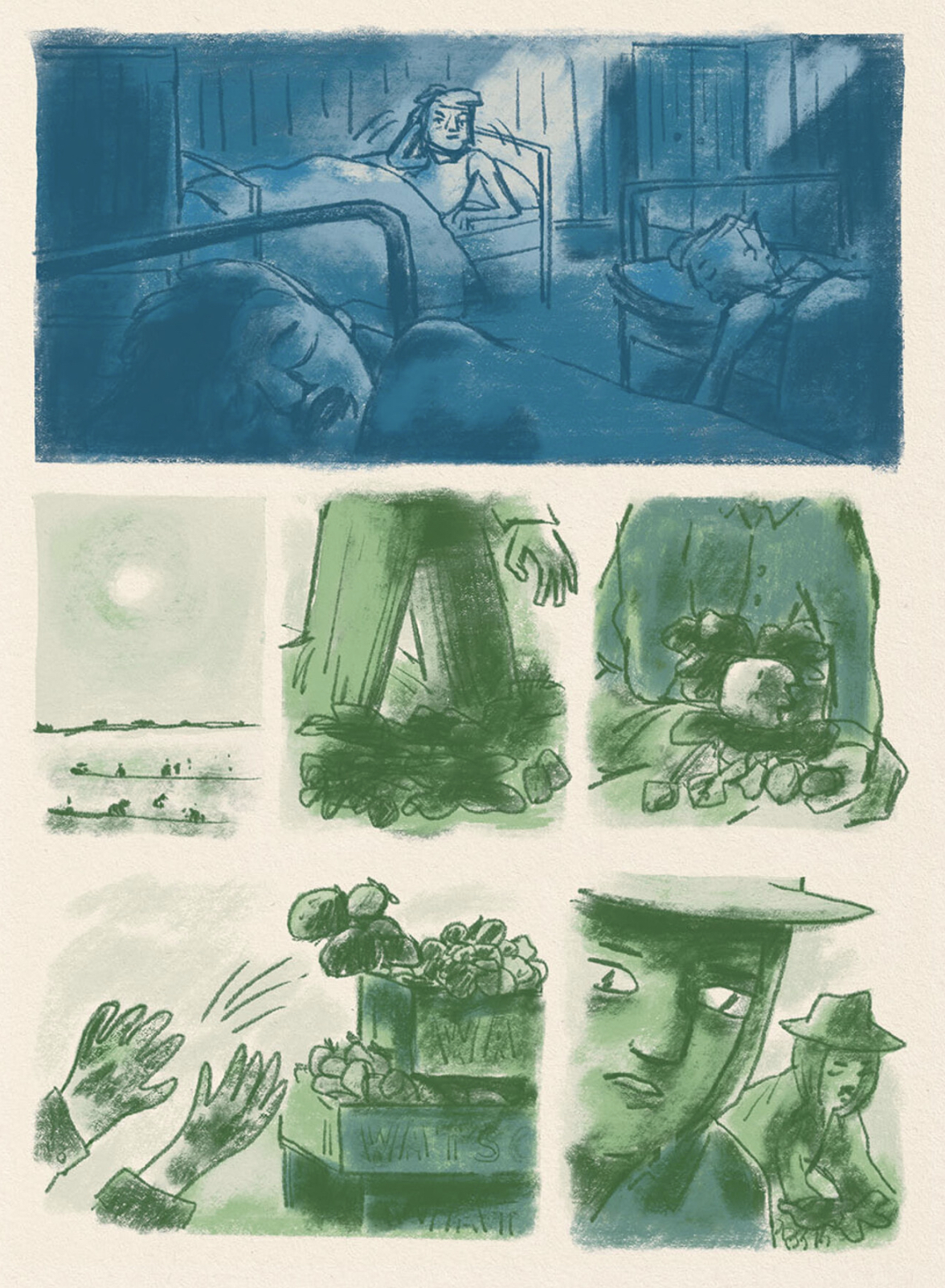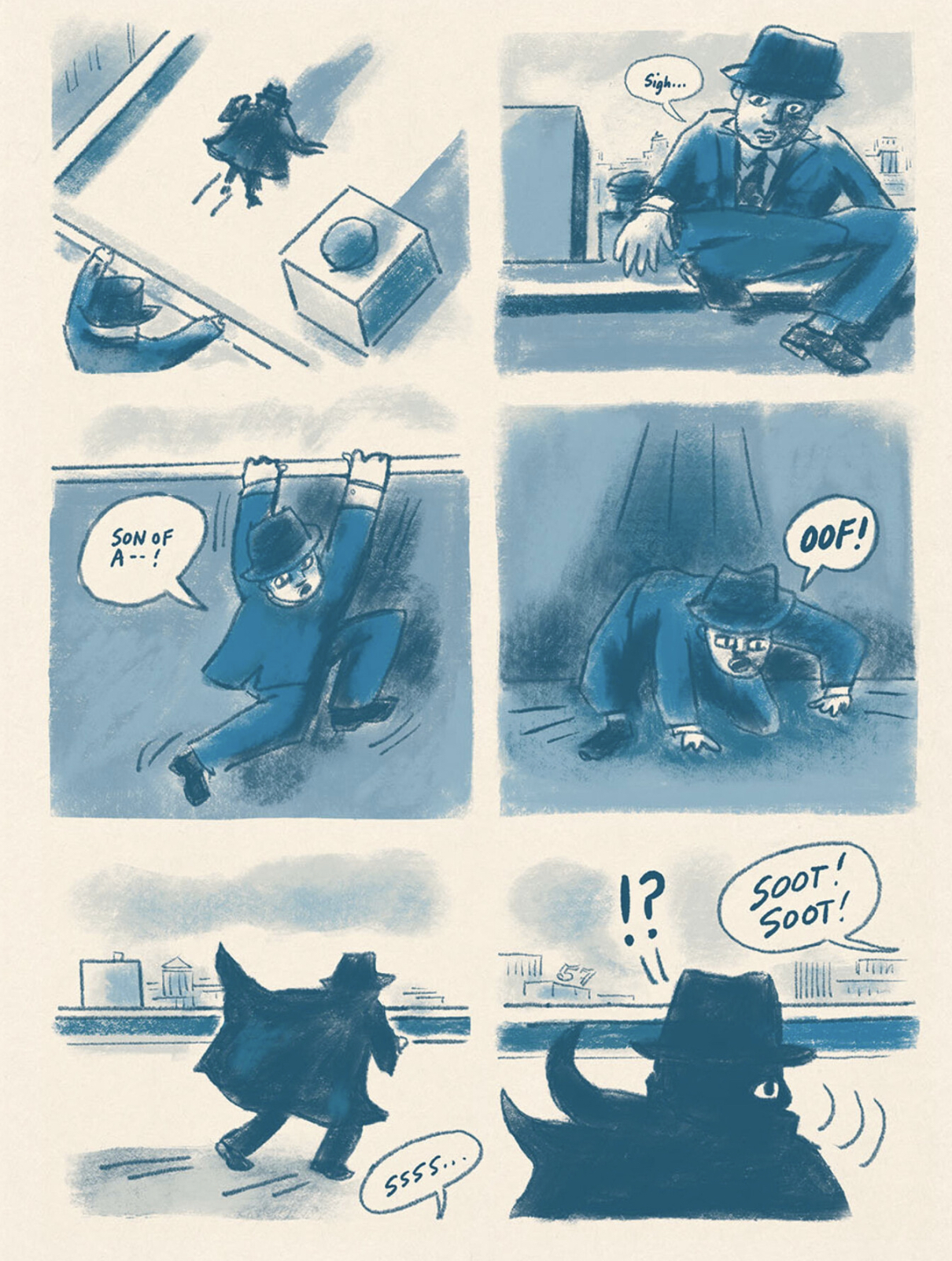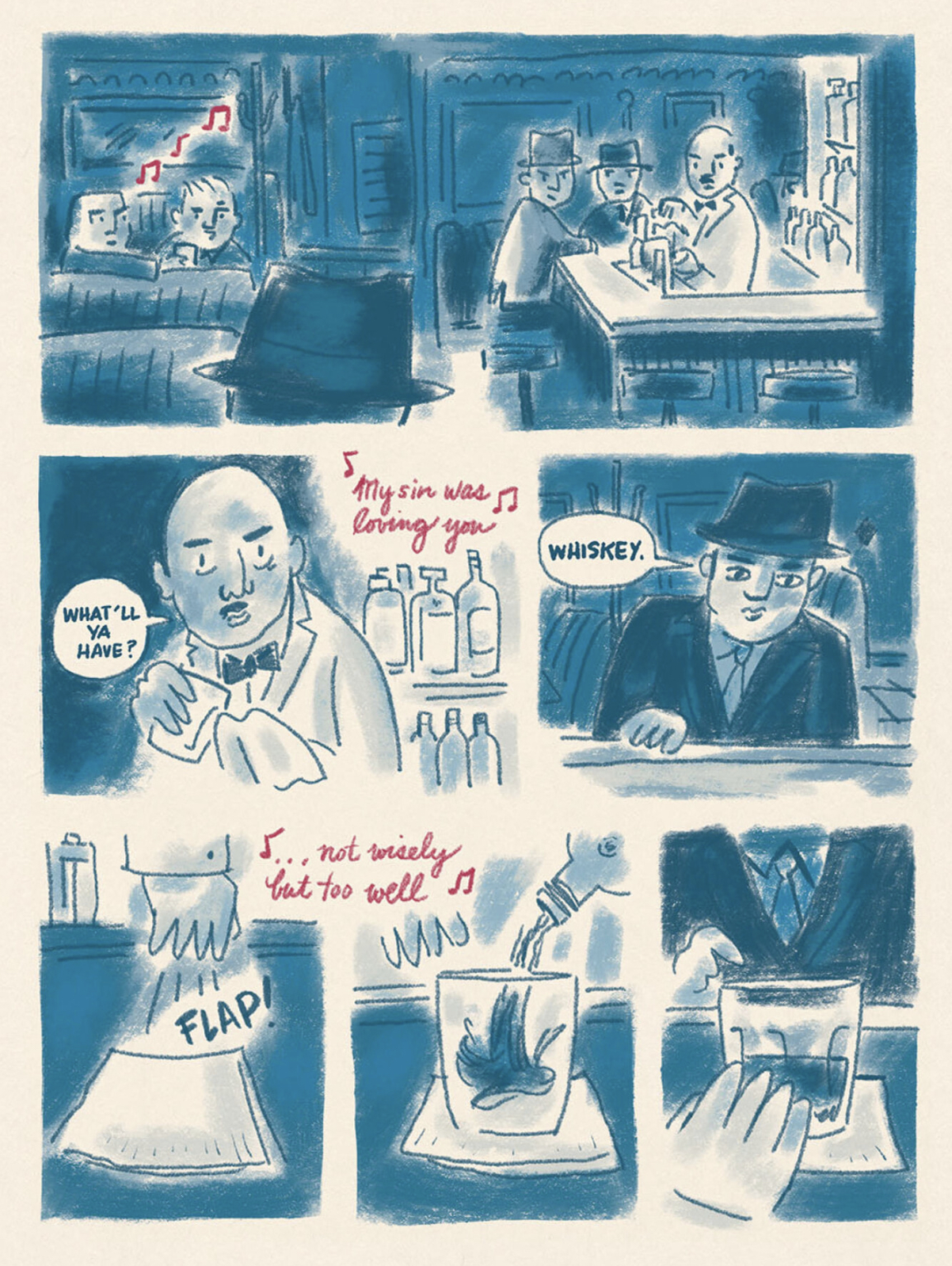Rina Ayuyang has long been a favorite of discerning comics readers, her pages built with a precise grasp of cartoon gesture and expression; her 2009 collection Whirlwind Wonderland was one of the latter day standouts of Sparkplug Comics, publishing in collaboration with Tugboat Press. Soon after, Ayuyang formed Yam Books, publishing the Lark Pien-edited sketchbook anthology Lollygag and notable books by Renée French, Tim Hensley and Mardou. An Eisner and Ignatz nominee—and a silver medalist at the Society of Illustrators' 2016 Comic and Cartoon Art Annual for her Cartoonist's Diary at the TCJ site—Ayuyang has recently begun working with Drawn & Quarterly, which published her 200-page crystalline color memoir Blame This on the Boogie in 2018. A significant evolution in the artist's use of frame-by-frame motion and evocative page design, that book is now followed by The Man in the McIntosh Suit, a final-roar-of-the-1920s period detective comic set among Filipino immigrants in California. Yet despite its seemingly total departure from Ayuyang's prior body of work, this new book exhibits the same expert fundamentals that make her comics compulsively readable.
In this interview, conducted by email in May of 2023, the artist MariNaomi—currently touring their own new book, I Thought You Loved Me, from Fieldmouse Press—discusses the genesis of and the thinking behind The Man in the McIntosh Suit with its author.
-The Editors
MARINAOMI: First thing: I absolutely loved your book from the get-go. The characters felt so fully realized, just bursting with personality. And the time and place - I could almost taste it. Tell me, how do you relate to the people, places and time in this book? I mean, what inspired you to write a story about immigrant agricultural workers?
RINA AYUYANG: Aw thanks, Mari! I’m glad you liked it. I’ve wanted to do a detective comic for years. I had Bobot, the lead character, in my mind since 2010, posting character studies of him on my old Flickr account. He’s been a part of me for a while. I knew he was going to be this hard-boiled, stoic, tortured film noir archetypal character, who all these other characters bounced their own complex personalities off of. And Estrella was always there in my mind, as a cross between actresses Anna May Wong, Cyd Charisse and Paraluman. All the other fun characters emerged later as I started to really write the book in 2020-21. They are all an homage to characters from film noir movies I love, Filipino movie stars, but especially relatives who immigrated to the U.S. by way of San Francisco during the 1920s. With them in mind, I knew I had to show the real-life situations these characters might have found themselves in at that time in history, such as dealing with anti-Asian hostility and violence, and having to settle for work in the fields or other manual labor to make some money for a new life and for their families back home.
Oh I love proto-Bobot! Thank you for sharing him. He started out so stern, not like the dreamy, romantic lead from your book. Did the story appear in tandem with developing the character or did that come when you started writing it out in 2020? And tell me how writing this fictional tale and characters felt compared to the memoir you do - did you start it off based on real-life stuff and people (like I did when I made the switch from memoir to fiction) and expand from there? Or... tell me about your process for switching to fiction!
Yeah, when I came up with the idea of Bobot detective comics in 2010, I was drawing comic strips where Bobot's life in San Francisco was already established. He was already a reputable private detective. The Man in the McIntosh Suit is, in a way, Bobot's origin story.
From the beginning, I knew the center of the story was Bobot trying to find his wife in San Francisco. While I was writing it years later, I was interested in the lives of the other characters who lived and worked alongside Bobot. I was also interested in the community where Bobot lived in both San Francisco and Watsonville. How did he interact with these communities? What kind of support did he get from them? And how were these communities thriving?
I've done short story fiction early in my comics career, but I've been doing autobio comics for so long that stepping back into fiction writing was intimidating. Making autobio comics comes easier to me because I love retelling stories and reminiscing past experiences, but as with fiction, you still have to go through that process of creating an interesting and engaging story from it all for the reader. That's where the problem-solving part comes in, which I love - especially when it all comes together in the end. I did feel some freedom when writing The Man in the McIntosh Suit, like I could play with a lot of the characters' personality traits and their motivations, but because it is set during a certain time in U.S. history, I wanted to make sure certain situations they found themselves in were as accurate as possible. So in that respect, it felt like dealing with autobio and memoir again.
The historical accuracy seems like it would be intimidating! What sort of research did you end up doing? And did you come across any surprises - any information that affected your plans for the stories or the characters?
I first learned about the Filipino American diaspora when I was a college student taking classes at the College of Ethnic Studies at San Francisco State University, but I really relied on digital archives, and publications made available from many professors, libraries, documentarians, Filipino community organizations. I was able to find photos of 1920 San Francisco and Watsonville, as well as news articles from local papers that showed just how prevalent anti-Filipino sentiment was at that time. I also had access to interviews and documentaries about members of the Manong Generation who worked in the fields and canneries on the West Coast. I also interviewed my mom and auntie who shared stories of their fathers’ experiences in the ‘20s and ‘30s San Francisco. That and finding so many photographs of relatives from that time made the whole experience of writing the book more personal. It was fun to see all these photos of my grandfather and uncles in stylish suits, and all the family gatherings that showed they had a real and normal life just like everyone else in America during that time.
Oh man, the suits! I loved all the outfits. When the guys clean up and dress nice to go out after their job harvesting strawberries, the relief and joy is palpable. This made me think a lot about folks who do this kind of work now, what they do to blow off steam. If they have fancy suits in their closet that they fantasize about putting on and blowing everything on a nice meal. How they're perceived by others, and can only get so far because of it.
Yeah, the suit felt like one of the few things these men had any real control over. If they couldn't get a good job they were qualified for, or they were banned from buying a home, at least they could save up for a suit that was tailored in the style they wanted just specifically for them. I think it gave them a sense of ownership. I mean, the suit is a symbol for a lot of things in the book, like status, gender, class and sophistication, fascination with Western culture, appearances vs. reality - the list goes on. I loved being able to play around with the suit both thematically and visually.
This book frames the anti-Asian sentiment at the time, but mirrors the anti-immigrant sentiment that unfortunately lives strong to this day. Was this your intent? Related: Aside from being entertained and blown away by your magnificent story and art, what are some things you'd like the reader to take away from your book?
When I started writing this book, it was near the beginning of the pandemic and when anti-Asian violence was starting to increase. I was doing research and reading all the local news articles during 1928-29 especially, and found all the anti-Filipino propagandist essays being written even by labor organization leaders and people in power, leading up to the violence against Filipino laborers and then the Watsonville Riots. The fear-mongering and scapegoating that was happening back then felt very, very palpable with what was happening to the Asian/Asian American community during the pandemic while I was writing the book. And I think that is why it was important to bring up those events in the book, because a lot of people didn’t know that Filipinos were in the Bay Area and being harassed, lots of people don’t know about the Watsonville Riots. It’s not really taught in schools outside of ethnic studies programs. So the more people know that these events in U.S. history happened, the more opportunity to go out and read more about it, and hopefully learn FROM it.
I didn't know about those things, so I'm your target audience! Are there any resources you'd recommend to learn more about them?
There are many books and articles you can read about Filipino American history and the Watsonville Riots that are easily accessible online. There is actually this great online exhibit about the history of the Filipino community in Watsonville called the Tobera Project. It includes a list of recommended reading as well. America Is in the Heart by Carlos Bulosan is definitely required reading about the Filipino immigration experience during that time. Also, I recommend work by historian and Filipino ethnic studies professor Dawn Bohulano Mabalon, who wrote about Little Manila, the Filipino community in Stockton and its involvement in the workers’ rights movement in California. There's also this great documentary short film available online called Dollar a Day, 10 Cents a Dance, that includes a lot of great interviews of Filipino manongs recounting their experiences as farm laborers in the 1920s and ‘30s. Also, organizations like the Filipino American National Historical Society, SOMA Pilipinas, and the Manilatown Heritage Foundation have programs, events, exhibitions, and other resources preserving the history of Filipino communities in San Francisco and throughout the U.S.
Ooh what a treasure trove, thank you! I didn’t know about the bachelor societies. It sounds kind of awful, but also kind of romantic in that bonding-among-trauma sort of way. You captured that really well in your book, the forced family of it all. Kind of like the comics community!
Let’s switch the conversation to technique. I recall hearing (maybe on IG Live with Vanessa Davis?) that this is the first book you fully scripted before drawing. Am I remembering right? If so, what did you think of the change, and is this a technique you want to use again going forward?
Yes! I did things totally differently than I normally do. I wrote a complete story outline first, then a script for each page, and then thumbnails. I never do that with autobio because when I write autobio it's more immediate and spontaneous. For this book, I knew I had to be totally organized and precise with the plot points and beats. This process worked pretty well and I see myself using it for future Bobot books.
You also played with color in this book in a really deliberate way. This book was done digitally, yes? Did that affect how you used color, or any other aspect of your art making?
Yes! Blame This on the Boogie was a celebration of Technicolor movie musicals so I used every color under the sun. With The Man in the McIntosh Suit, I wanted to use a smaller and more strategic color palette. I chose shades of blue to get that mysterious classic film noir look in foggy San Francisco. I still wanted to have fun with color. Color is my thing, right?! So I used specific colors to evoke certain emotions, places, moments in time, especially when Bobot thinks about the past or his wife. At first this was all going to be done with Copic markers and colored pencil, but I started to get really comfortable with Procreate on my iPad. Finding the right brushes in Procreate made me enjoy using it as a drawing tool. When I used colored pencils, I put so much pressure on the paper, because I like bold colors, that it was hurting my hand and wrist more. My hands started to relax more when drawing with an Apple pencil.
OMG, I switched to an iPad because color pencils were killing my hands too! The struggle is real.
Tell us about what you've got coming up! Do you have a book tour planned?
I started my tour at the beginning of May in Toronto, New York, and the Bay Area. I’ll round it out at Skylight Books on June 15 with an in-conversation event with Pornsak Pichetshote, the creator of The Good Asian comic series. I’m very excited about that! And I will be a part of an amazing summer comics residency from June through September with Bay Area cartoonists Tyler Cohen, Janelle Hessig, and Thien Pham at 836M Gallery. It’s this amazing space in the heart of Jackson Square in San Francisco. For my project, I’ll be making a minicomic about Manilatown, which was once a thriving Filipino community right next to Jackson Square. It’s definitely going to be an inspirational experience and exercise for preparing for the next Bobot books. We will have a bunch of events planned at the gallery space for the community to participate, so make sure to stay tuned via all our Instagram accounts and the 836M Gallery’s website.
Skylight is the best! And that residency sounds amazing. Now the dreaded question: What are you working on next?
Ha! Well, I’m starting work on the next book in the Bobot detective series. And she doesn’t really know this yet, but I’m starting to compile some notes on a book about my mom.
Oh hell yes, I love mom-oirs! Is it okay to put this in the interview?
Yes! You can put it in!
You can tell her about it by forwarding her the interview, haha! What advice would you give young Rina, if you could go back in time to when you were first thinking of making comics?
Hmm, I think I would tell myself to not get discouraged, and keep making comics and sharing the stories I cares about. And just enjoy creating and continue to immerse myself with art that moves and inspires me.
Lastly, what are you excited for in the future of comics?
I love knowing that comics will always be a platform/genre/medium/format/art form/whatever we want to call it that artists choose to tell their stories, and that readers will continue to give comics a chance. I am excited that new cartoonists and students continue to see comics as a platform to experiment and try things out with their art and their storytelling. I love that the possibilities of comics will continue to be limitless. And I hope that the comics community continues to be inclusive and supportive as it was when I first started making comics again 20-some years ago.


















